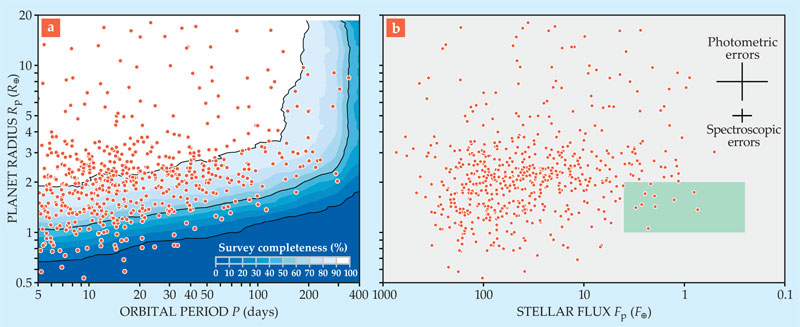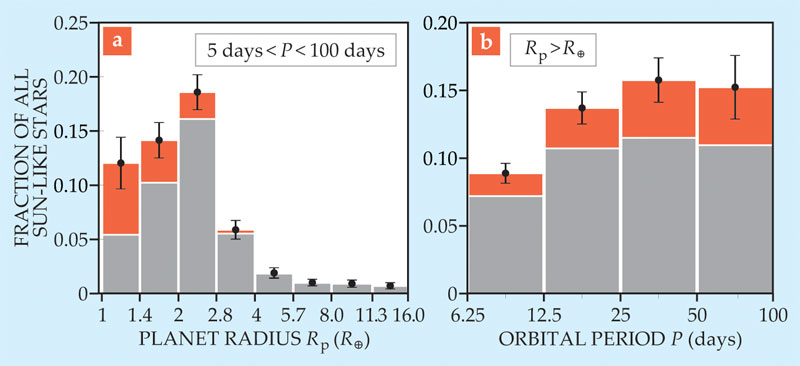Earth-size exoplanets in habitable orbits are common
DOI: 10.1063/PT.3.2230
The Kepler telescope was launched into an Earth-trailing orbit around the Sun by NASA in March 2009. Its principal mission was to continuously monitor large numbers of stars over long periods in search of the very slight periodic dimming that might indicate the repeated transit of an exoplanet across the face of its host star. To that end, the telescope has photometrically measured the brightnesses of about 150 000 nearby stars in a patch of northern sky (the Kepler field) every half hour for the past 4 years. That prodigious undertaking has yielded some 3500 planet candidates.
From any given vantage point, transiting exoplanets are rare. And they’re hard to recognize by photometric monitoring. Easiest to spot are giant planets in tight, short-period orbits around relatively small stars. To obtain a reliable census that reflects the true abundance of planets and the distribution of their characteristics, one must correct transit data for such observational biases.
Particularly disfavored by observational biases is a quest of great general interest: the search for Earth-size planets orbiting Sun-like stars at separations amenable to life. A distant photometric observer fortuitously close to the plane of Earth’s orbit would record Earth’s transit as a 0.01% dimming of the Sun’s brightness for about 10 hours once a year.
Confirmation of periodicity requires at least three consecutive dimming episodes. So only after three years of uninterrupted monitoring could the Kepler data begin to reveal planets orbiting Sun-like stars with periods on the order of a year. Until now, published analyses of Kepler data have concentrated on orbital periods less than 50 days. For solar-mass stars, that limit corresponds to orbital radii smaller than 0.25 astronomical units (1 AU is Earth’s mean distance from the Sun).
But now, with 3½ years of Kepler photometric data publicly available, Geoffrey Marcy (University of California, Berkeley), his graduate student Erik Petigura, and Andrew Howard (University of Hawaii at Manao) have reported an analysis of the data that identifies 603 planets orbiting Sun-like stars, including a few with periods longer than 300 days. 1 Having corrected for observational biases and limitations, the team has estimated the demographics of planets harbored by such stars, with particular emphasis on the abundance of Earth-size planets orbiting in the “habitable zone”—neither too close to the star nor too far to allow liquid water.
The search
Restricting their analysis to stars closer than 3000 light-years with low photometric noise and Sun-like surface temperature and gravity (of order 30 g), Marcy and company selected the 31⁄2-year photometric records of about 43 000 of the Kepler stars for their planet search. Their automated search engine was an elaborate, purpose-built software package called TERRA, developed by Petigura. The program cleansed the photometric records of suspect outliers, intrinsic stellar brightness variations, and a variety of other systematic errors. It then searched for transit events with repetition periods from 5 to 400 days.
Petigura next vetted, by eye, each of the few thousand records for which TERRA had found transit evidence, to weed out anomalies due to instrumental or cosmic-ray effects. In each half-hour scan of the Kepler field, the brightness of any given star was always measured by the same small cluster of CCD pixels from among the 100 million that tile the telescope’s image plane. So a failing pixel or an incident charged particle could simulate a change in stellar brightness.
Finally, the team imposed cuts intended to minimize contamination of the sample by transits of binary stellar companions. Chief among those cuts was the rejection of any candidate whose radius, as measured by the depth of the dimming trough, exceeds 20 times Earth’s radius R⊕. The fractional dimming of a star of radius R* during the transit of a planet of radius Rp is simply (Rp/R*) 2 .
The harvest
The team’s final sample of 603 planets is plotted in figure 1a in terms of Rp and orbital period P. The color scheme indicates the survey-completeness factor C for different regions of the parameter space, as determined by Petigura from 40 000 mock transit profiles injected into the TERRA pipeline to see how efficiently they’re recovered.

Figure 1. The 603 exoplanets transiting Sun-like stars found in a search of Kepler telescope data are plotted against planet radius and (a) orbital period or (b) stellar irradiation flux. (The units R⊕ and F⊕ are the values for Earth.) In panel a, the color scale indicates the variation of survey completeness C, the fraction of planet transits in the noisy Kepler data that the search was expected to reveal. The green patch in panel b indicates an Earth-like region with planet radii 1–2 R⊕ and stellar fluxes within a factor of 4 of F⊕. The representative crosses show how uncertainties are reduced by follow-up stellar spectroscopy. (Adapted from ref.

The completeness factor estimates only the fraction (1 − C) of actual transits that the pipeline, including eyeball vetting, would have lost. It does not take account of the much greater loss of planets simply because they don’t exhibit transit in the observer’s direction with respect to their randomly tilted orbital planes. That loss must, of course, also be corrected for in estimating planetary abundances. But it’s a straightforward geometrical correction.
In figure 1b, the stellar irradiation flux Fp at the planet’s orbital distance replaces P on the abscissa. That flux is calculated from the orbital separation and the star’s intrinsic luminosity, which is determined from its surface temperature and area. The solar flux F⊕ at Earth’s mean distance from the Sun is 1.36 kW/m2. The green patch in figure 1b indicated an Earth-like zone, with planet sizes 1–2 R⊕ and fluxes 0.25–4 F⊕.
Because uncertainties in stellar size R* contribute strongly to uncertainties in both Rp and Fp, the team refined the size determinations of the 60 stars with planets in or nearest to the green patch by follow-up spectroscopy at the Keck I telescope in Hawaii. The representative crosses in figure 1b show how much the stellar spectroscopy reduces the uncertainties in the planetary parameters.
The chosen flux range for the green patch is a rather generous demarcation of the habitable zone. Applied to the solar system, it would include both Venus and Mars. “But obviously,” cautions Howard, “habitability depends on more than just stellar flux. Reflectivity and greenhouse gases, for example, can strongly affect a planet’s surface temperature.”
Corrected abundances
Figure 2 shows the estimated fraction of Sun-like stars with planets of different sizes and orbital periods. The distributions are corrected both for losses in the TERRA pipeline and for all the planets that—as viewed from Earth—simply don’t cross the faces of their host stars. The plotted fractions are, strictly speaking, lower limits. That’s because when TERRA encounters evidence of more than one transiting planet in a star’s photometric record, it discards—for simplicity—all but the candidate planet with the best signal-to-noise ratio. “If we could have included all those sister planets,” says Petigura, “our harvest would have been about 25% bigger.”

Figure 2. Estimated fraction of Sun-like stars having planets of different (a) sizes Rp and (b) orbital periods P. Intervals are logarithmically equal. Gray bars represent transiting planets actually found. Orange extensions are corrections for the fraction (1 - C) lost in the noisy photometric data. Abundances are also corrected for all the exoplanets that don’t happen to exhibit transits in Earth’s direction. (Adapted from ref.

As seen in figure 2a, the size distribution of planets falls sharply at about 3 R⊕. So around Sun-like stars, small, mostly rocky planets typically predominate over gas giants like Jupiter and Saturn (roughly 10 R⊕) and gas middleweights like Neptune and Uranus (4 R⊕). Our solar system, with its equal numbers of gassy and rocky planets, turns out to be atypical.
That result favors the core-accretion scenario of planet formation, disputed by some, which asserts that accretion of a rocky core precedes the accumulation of a gas envelope from the star’s protoplanetary disk. But theorist Alan Boss (Carnegie Institution of Washington) points out that the disk-instability model he has proposed for the rather abrupt formation of gas giants “operates only at greater orbital distances than Kepler has been able to sample.”
Figure 2b shows the planetary-occurrence distribution in orbital period P. Its principal message—borne out by more detailed representations of the data—is that beyond about 20 days, the distribution is roughly constant in equal intervals of log P. And it’s rather insensitive to planet size.
The approximate logarithmic constancy in P implies the same constancy in Fp. The team has exploited the latter to augment its very meager sample of Earth-size planets with Fp less than F⊕ by means of “a modest extrapolation” from somewhat higher fluxes. That extrapolation yields the conclusion, widely noted in the media, that 22 ± 8% of Sun-like stars have at least one planet of size 1–2 R⊕ in the habitable zone of stellar fluxes from 0.25 F⊕ to 4 F⊕.
That striking conclusion means that there must be Earth-size planets in relatively comfortable orbits around Sun-like stars within a few dozen light-years of the solar system—unless our local neighborhood is very atypical. Such stars, visible to the naked eye, should be amenable to planetary imaging and atmospheric spectroscopy with modest instruments. Some of those planets might then be promoted from “Earth-size” to “Earth-like.”
There’s no reason to assume that habitable Earth-like planets are exclusive to Sun-like (GK-type) stars. Courtney Dressing and David Charbonneau at Harvard University recently reported the results of their search of the Kepler-field data for Earth-size planets orbiting M dwarfs—stars smaller and cooler than the GK stars. 2 Small planets are easier to see in transits across M dwarfs, because they occult larger fractions of the smaller stellar disks. Dressing and Charbonneau estimate that about 15% of M dwarfs have Earth-size planets in their habitable zones.
Kepler impaired
The estimates by the two teams are unlikely to be improved upon in the next few years. “Kepler has revealed far more exoplanets than all the other instruments put together,” says Marcy, himself a pioneer of the Doppler-oscillation technique that revealed most of the early exoplanets (see the article by Jonathan Lunine, Bruce Macintosh, and Stanton Peale in Physics Today, May 2009, page 46
The orbiter is now scheduled for less demanding tasks. But those cannot provide the anticipated four more years of Kepler-field surveillance that would have significantly sharpened the abundance estimates—especially for planets with longer orbital periods.
References
1. E. A. Petigura, A. W. Howard, G. W. Marcy, Proc. Natl. Acad. Sci. USA 110, 19273 (2013). https://doi.org/10.1073/pnas.1319909110
2. C. D. Dressing, D. Charbonneau, Astrophys. J. 767, 95 (2013).https://doi.org/10.1088/0004-637X/767/1/95
